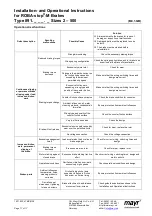
Installation- and Operational Instructions
for ROBA-stop
®
-M Brakes
Type 891. _ _ _ . _ Sizes 2 – 500
(B.8.1.GB)
16/11/2005 TK/KE/RJ
Chr. Mayr GmbH + Co. KG
Tel.: 08341 / 804-0
Eichenstraße 1
Fax: 08341 / 804-421
D-87665 Mauerstetten
http://www.mayr.de
Page 11 of 17
Germany
eMail:
9. Electrical Connections
Basics
To operate the brake, D.C. current is required. The coil voltage is
stated on the Type tag and also on the brake body. It is based on
DIN IEC 60038 (±10% tolerance). Operation can take place via A.C.
voltage in connection with a rectifier or with another suitable D.C.
power supply. The connection possibilities vary depending on the
brake accessories available. Please follow the exact connections
according to the wiring diagram. The manufacturer and the user
must observe the applicable regulations and standards (e. g. DIN
EN 60204-1 and DIN VDE 0580). Make sure that these standards
and regulations are upheld and checked!
Earth Connections
The brake is manufactured for Protection Class I. This protection
can only be guaranteed if the basic insulation is intact AND if all
conductive parts are connected to the permanent installation
Protective Earth conductor. Should the basic insulation fail, the
contact voltage cannot function. An standardised inspection must
be carried out on the PE conductor connections leading to all
contactable metal parts.
Device Fuses
To protect against damage caused by short cuts, it is necessary to
equip the mains supply with suitable device fuses.
Switching Behaviour
The safe operational behaviour of a brake is to a large extent
dependent on the type of wiring used. This also affects the
temperature switching times as well as the air gap between the
armature disc (3) and the coil carrier (2), dependent on the wear
condition of the linings.
You must use the switch contacts, User-category AC-3 according to
EN 60947-4-1 to switch the brake.
10. Magnetic field build-up
When the voltage is switched on, a magnetic field is built up in the
brake coil, which attracts the armature disc (3) to the coil carrier (2).
The brake is released.
Magnetic field build-up with normal excitation.
When a nominal voltage is applied to the magnetic coil (7) via a
half-wave or a bridge rectifier, the coil current will not reach its
nominal value immediately. The inductivity of the coil causes the
current to rise slowly in the form of an exponential function.
Therefore the production of a magnetic field and the reduction in
braking torque are slowed down accordingly.
Magnetic field build-up with over-excitation.
An accelerated reduction in torque can be achieved by applying the
coil temporarily to a higher voltage than the nominal voltage,
thereby increasing the current more quickly.
If the brake is released, it is necessary to switch to nominal voltage
(Curve 2 / Fig. 6). The relationship between over-excitation and
disconnection time t
2
is approximately indirectly proportional. That
means that, using doubled nominal voltage, it is possible to halve
the disconnection time t
2
needed in order to release the brake. The
ROBA
®
-switch fast acting rectifier and phase demodulator work on
this principle.
The over-excitation voltage must only be up to max. 200 % more
than the nominal voltage. The over-excitation time should be 200%
of the disconnection time t
2
with nominal voltage.
The permitted cycle frequency may not exceed 1 cycle per minute.
For deviations please calculate the actual coil capacity P
eff
(see
Operational Instructions, Rectifier).
Fig. 6
[W]
t
t
P
t
P
P
tot
hold
hold
over
over
act
=
×
+
×
=
Important: P
eff
≤≤≤≤
P
nom.
(see Table 1)
P
act
[W] Effective coil capacity, dependent on the cycle
frequency, the over-excitation and the switch-on time
period.
P
nom
[W] Nominal coil capacity (see information in catalogue
or on the Type tag).
P
over
[W] Coil capacity on over-excitation.
P
hold
[W] Coil capacity for output DC voltage.
T
over
[s]
Time of over-excitation.
t
hold
[s]
Time of holding voltage.
1
t
1
t
2
2
I
M
Braking torque development
M
nom.
I
nom.
Current development



































